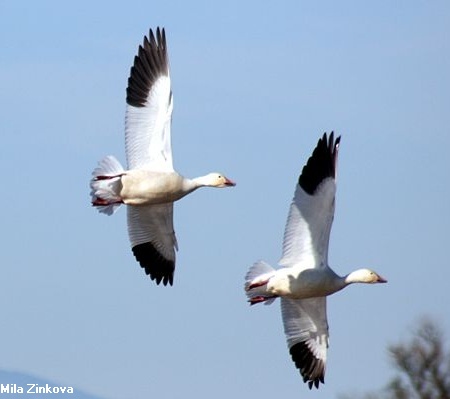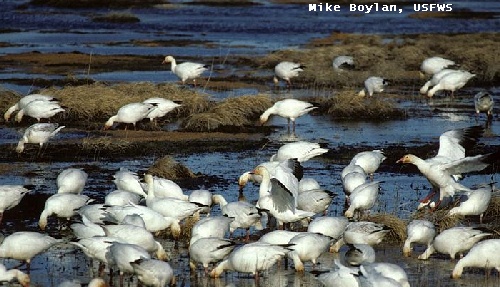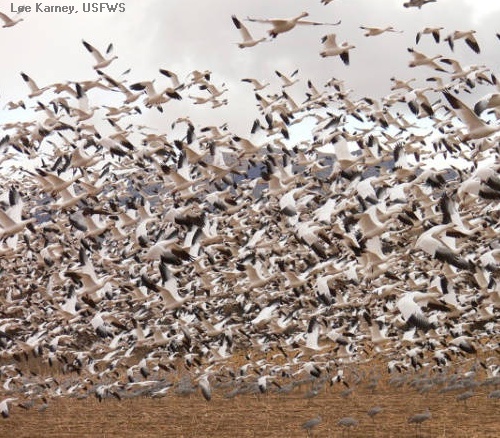
image credit - Mila Zinkova Wikimedia , license - Creative Commons Attribution-Share Alike 3.0 Unported

Snow geese spend the winter in the United States and Mexico. In the spring large flocks of geese migrate to nest and raise the young on the Arctic tundra. The geese nest in colonies by the tundra pools.DESCRIPTION
There are two subspecies of snow geese - Greater Snow Goose and Lesser Snow Goose. The Lesser Snow Goose is slightly smaller. Most snow geese are white with black wing tips. Some are blue-grey in colour with white heads and necks. These are known as "blue geese". Snow geese have pink feet and bills.
image credit - Dave Menke, US Fish and Wildlife Service; license - public domainThe goose looks like it is smiling or grinning because of a dark markings formed by the cutting edges on the side of the bill.
Sound - the snow goose makes a loud, nasal whouk or houck.
NESTING / YOUNG BIRDS
Large colonies of snow geese nest on the tundra in late May. The nest is hollow on the ground lined with down (feathers) and plant material (moss, willows, grasses). An egg is laid every 36 hours. Two to six eggs are laid. The average is four eggs.
Once all the goslings hatch they leave the nest within 24 hours. They begin to look for food and are able to swim and dive. At first they eat insects, then feed on grasses and sedges when two weeks old. The young and the parents spend most of the time eating. They must be strong enough for the long flight south in the fall.
FOOD
Snow geese feed on the roots and leaves of grasses, sedges, willows and other plants. During the Arctic summer when there are many hours of daylight, they are constantly eating.
During migration they eat the roots of bulrushes. By using their strong sharp bills they are able to dig the roots from the mud. Flocks land in farmers' fields to feed on grains left behind after harvesting. They also graze on pasture grasses, weeds and clover.
On the wintering grounds the geese feed on grasses, water plants and grain left in fields. In the spring they must fatten up again for the long flight to the nesting grounds in the Arctic. Flocks of several thousand can be seen feeding in fields or marshes.
In late August and early September, the Western Canadian Arctic population (Lesser Snow Geese) flocks to the coastal plains of the Arctic National Wildlife Refuge in Alaska to feed on cottongrass. They fatten up by eating the underground stems of cottongrass. This supplies them with energy needed for their migration south to the wintering grounds.
ENEMIES
Arctic foxes, gulls and jaegers eat the eggs and the young goslings. Other predators are arctic wolves, ravens, gyrfalcons and eagles.
During moulting, the geese usually stay close to ponds and lakes to escape.

HABITAT / RANGE ( map )- nests on the Arctic tundra along the coast and on islands
- builds nest near ponds and streams
-found in Canada, Alaska, Greenland, Siberia
-migrates south to warmer areas for the winter
-flocks can be so large they block out the sun
-winters in coastal marshes and bays, wet grasslands, freshwater marshes
-also winters inland and feeds on waste grain.Most of the western Arctic population of Lesser Snow Geese breed on Banks Island (Northwest Territories) with four smaller colonies on the mainland of the Northwest Territories and Alaska. Bylot Island (Nunavut) is the world’s largest Greater Snow Goose breeding colony.

OTHER FACTS
In the early 1900s hunting of the snow goose was banned. Now the population is estimated at over six to seven million worldwide. (Lesser Snow Geese are very numerous.) Hunting snow geese is now allowed during spring and fall migration.
Snow geese are destroying habitat. The geese strip the land bare by eating plants right down to the ground. They cause damage to saltwater and freshwater marshes. Farmers' crops and pastures are damaged during migration.
.
| THE ARCTIC : INTRODUCTION ** PEOPLE ** ANIMALS ** PLANTS ** ARCTIC INDEX |